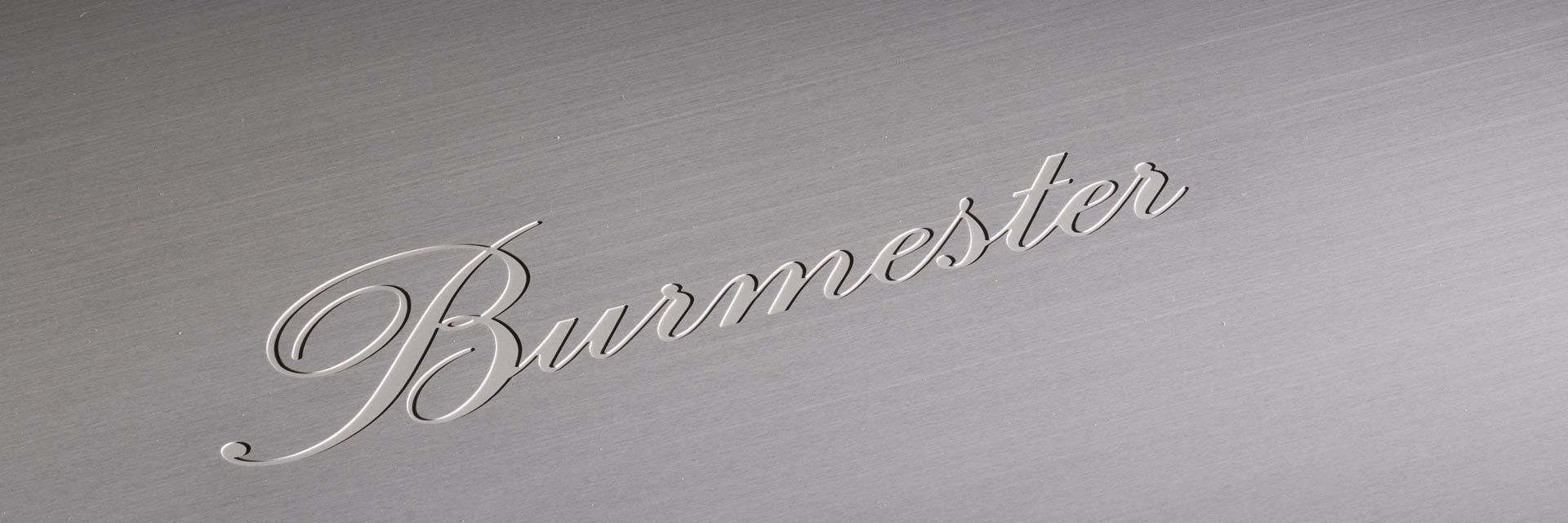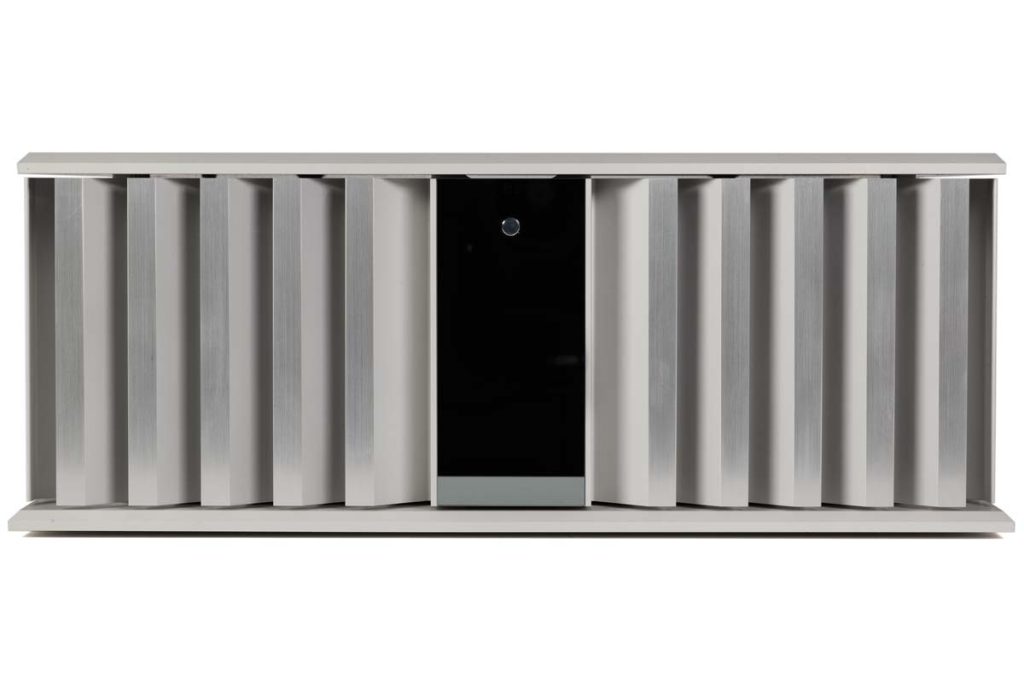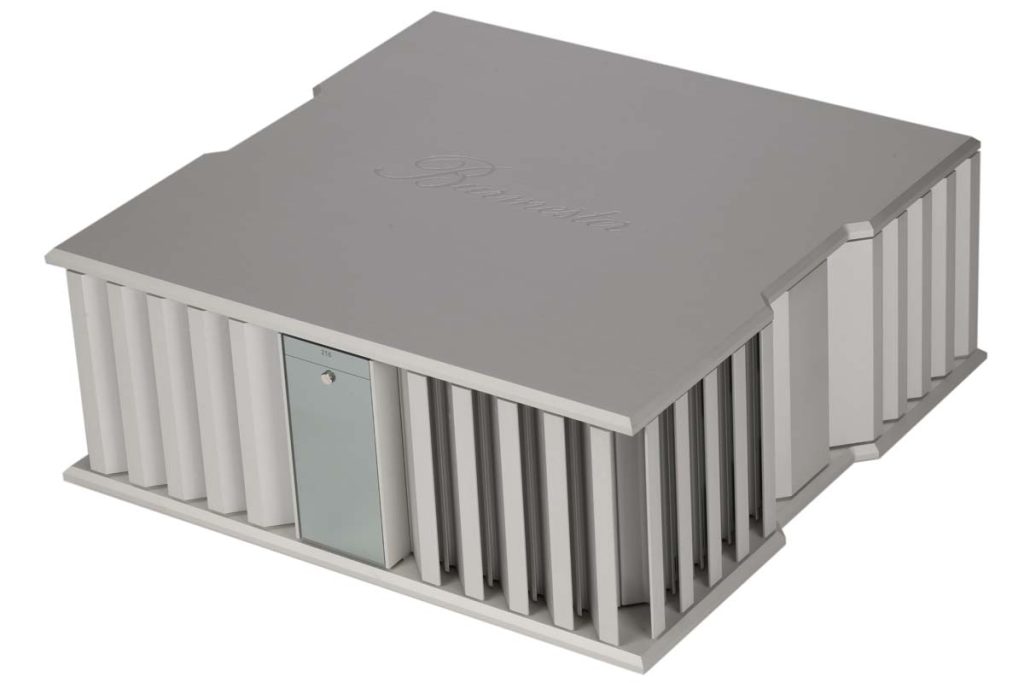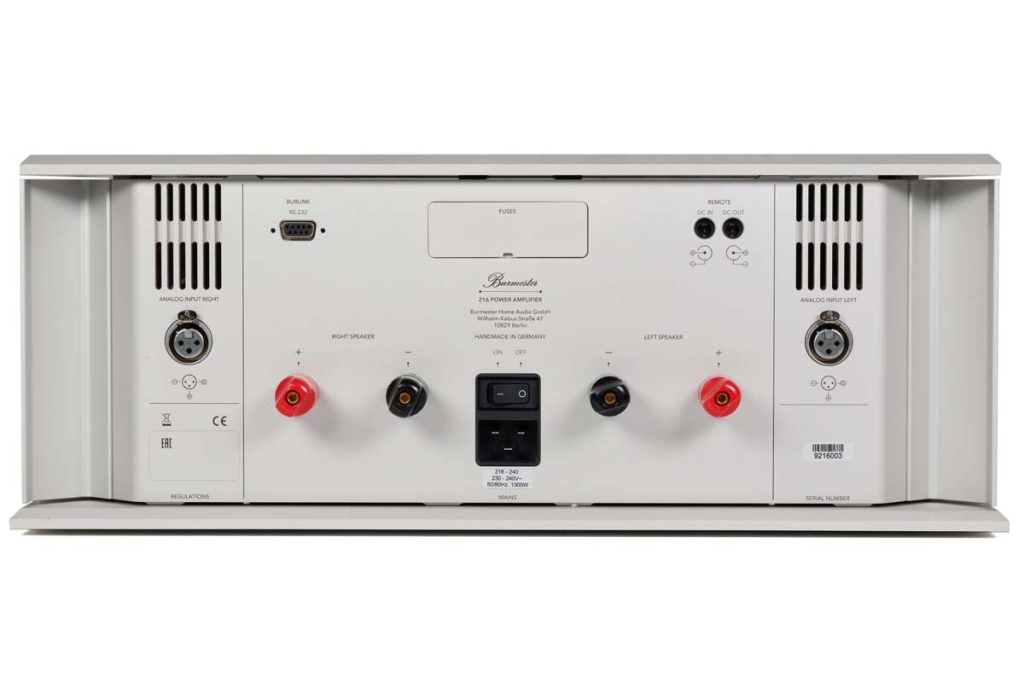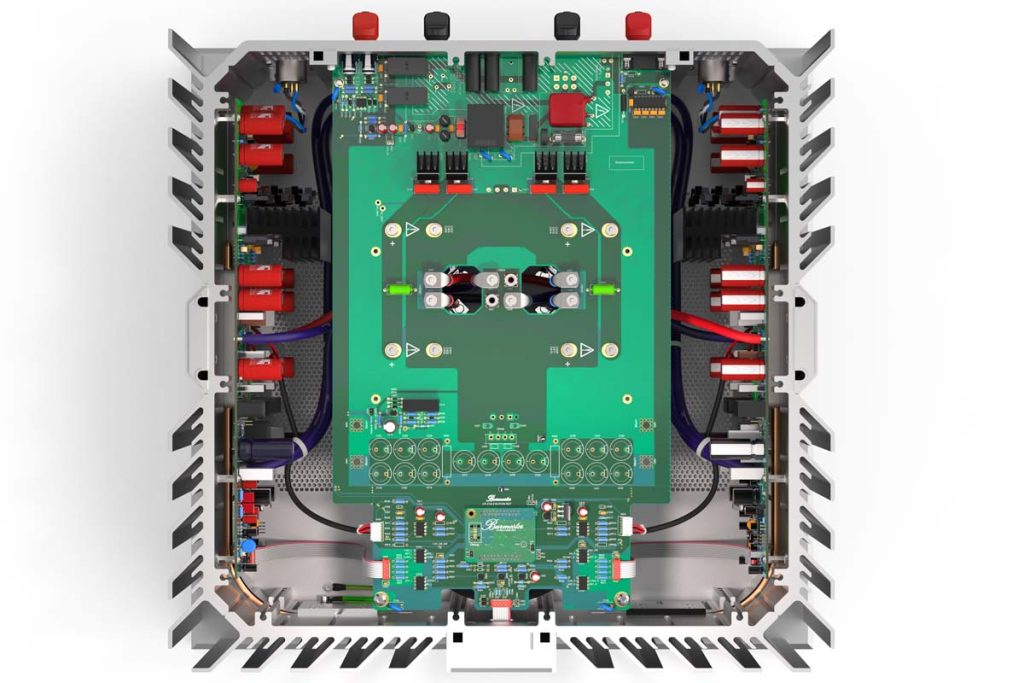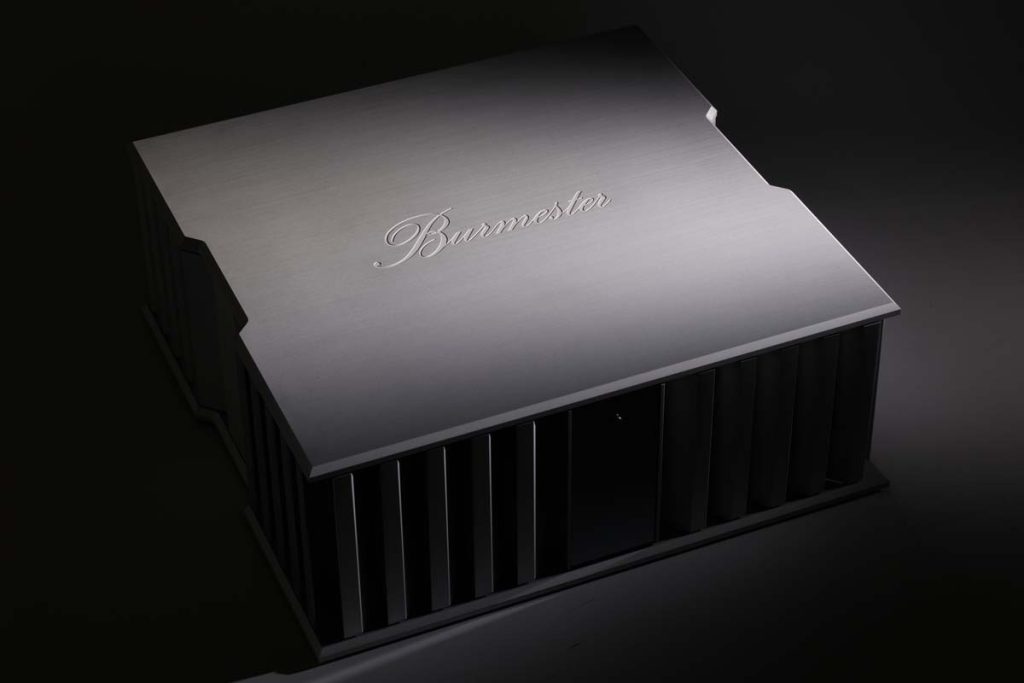Engineering, mathematics and materials science are not very pleasurable for most people. But the Burmester 216 shows how science can help make music soar.
It’s not easy for me to admit, but for some time I barely set foot in my living room. Then suddenly this shiny sculpture appeared that looked a like someone had rebuilt the BND headquarters in the block game “Minecraft”, with inspiration from Doric columns. What hides behind the noble facade? One can only guess, but it must be infinitely raw and powerful. After a while, the queasy feeling subsided. And it disappeared faster than the sore muscles from unpacking and placing the Stereo Power Plant Burmester 216.
You take off the supplied gloves, and stow away the equally supplied polish for later use. Then, marvel at the power cord (which isn’t a cord, but a veritable hose with a small marker for phase and neutral), and take in the colossus. The chrome is dazzling, but there isn’t much to see at the front anyway: A small button, a red or green LED and a well-hidden infrared sensor for an optional remote control. All the rest is a screw-less real estate unit weighing in at 35 kilograms. And the 216 “only” part of the Top Line for medium requirements and demands. With the 218, the Berlin high-end manufactory offers a second stereo power amplifier developed from scratch and positioned in the larger Reference Line. It weighs more and has even more power. It could likely provide high-quality sound for the ballroom of a castle. As for transducers, the 216 isn’t picky: it’ll take on any impedance and load you throw at it.
The legendary 159 model inspired the new development of both amplifiers, which are similarly constructed. This is especially true for the striking design and perfect workmanship down to the last detail. However, in direct comparison to the 159, the 216 seems downright compact. On its rear, there’s not much out of the ordinary. What more does a power amplifier need than a power jack and switch (in this case a rectangular C20), balanced inputs for left and right and connections for a couple of transducers? For owners of a Burmester chain, the “BurLink” connection for external control is useful. If you do want to change the operating state, then the remote jacks are available. The 216 allows for mono operation and bi-amping – which logically requires purchasing two of these components.
The inner workings follow the typical Burmester maxims. The Burmester 216 is completely balanced and DC-coupled. The protection circuit is located outside the signal path and has been further refined, and the input stages follow the proven “X-Amp” technology. They have a high damping factor over the entire frequency range and a very wide, distortion-free Class-A range. However, there is no excessive heat generation—it is imperceptibly dissipated via the numerous cooling fins. The signal processing reaches the input signal unaltered via silver cables, and the signal is routed out again unaffected. After all, that’s how it should be in an amplifier.
However, at Burmester you can rest assured that it is as it should be: the components and wiring are of extremely high quality, and the tolerances are extremely low. Each unit is manufactured with infinite care, and by people who know their craft. If you’re privileged to visit the manufactory in Berlin-Schönefeld, you’ll observe how research and tinkering is done just like in “the olden days”. At Burmester, rather than industrial production lines, there are individual workstations where people struggle against the limits of physics in painstaking detail. And I witnessed this meticulousness in the run-up to the loan of our test unit. Before it was delivered, the service department called to let me know how far they had progressed with the measurement and quality control of “our” 216.
Of course, such manufacturing and service has its price. However, you also get what money really can’t buy: That carefree feeling. The quality of workmanship is self-evident in the massive speaker terminals, which hold spades and banana plugs inexorably tight. Furthermore, you don’t need a deeper expertise in metalworking to feel that every gap has been perfectly executed and the Burmester logo engraving fits exquisitely. And the measured performance? It’s as clean as can be. All that’s left for you to do is just enjoy the listening experience. And that is nothing less than spectacular. After just a few deflections of the diaphragms, the thought crosses my mind that the eye-catching design of the 216 is meant to remind me that music is still conveyed to me electrically. Without this visual nudge, I would have immediately forgotten that. Very often, you can hear people rave about how the music “detaches” from the transducers. With the Burmester 216, one should rather say: the whole world around you becomes music.
And the whole world for me is first of all Madonna’s Music. Of course, such a production does not sound like a concert hall. But it doesn’t sound dense and compact like the studio either. Rather it’s so lively and energetic that it nearly jumps out at me. Every impulse is immediately present, the voice reproduction natural and immediate, left, right, above, below. The imaging is airy and completely three-dimensional. Gone is the need to pick demanding recordings out from the collection that would pose challenging tasks for the 216 with their complex sonic constellations, or otherwise probe any potential limitations. Instead, I’m driven to give the amp the beans over a glass of red wine.
But before you presume that I want to present the 216 as a limitless fun machine: At times, I have also been frustrated when listening to music. For example, when streaming via Qobuz or Tidal, one regularly encounters remasterings that may sound impressive for three and a half minutes, but then quickly tire and leave a stale feeling of less than authentic playback. Music from 1969 simply shouldn’t sound like the Foo Fighters. However, the Burmester manages an interesting balancing act here. An enormous effort has been made to ensure that it is decidedly neutral with its eminent power, and caring with the incoming signal. In turn, it reproduces exactly what may have happened in the manufacturing and playback chain before it: Providing the most accurate information about how the recording should be judged, and mercilessly showing the strengths and weaknesses of the sources. And yet, when I stream Abbey Road by the Beatles, I can’t stop until the closing track, “Her Majesty,” has come to its abrupt end. The musicality of this outstanding powerhouse pulls me into the recording so that the sudden silence after the 25-second song hits me like thunder!
It is undoubtedly an emotional experience to share your living space with the Burmester 216. And this, in some cases, might be more expensive than the entire living room. 24 000 Euros for a power amplifier—you have to be able to afford that. On the other hand, the “wanting to afford” comes all by itself once you have experienced the beast. In return, you not only get a component that is one of the best of its kind, but also a musical experience that you won’t soon forget. Mind you: I’m not talking about the finest nuances, which the Burmester perhaps brings out better than others. It does this in passing, so to speak. More important is the entire projection, the immediacy, and, in short: the music.
Accompanying Equipment
Sources: Creek Evo 2, Lumin X1, Soulnote Z-3, Audio Note CD3.1x/II | Amplifiers: Aavik I-880, TEAC AP-701 | Loudspeakers: Wilson Audio Sasha DAW, Neat Momentum 4i, Bryston Mini A, Focal Alpha 80
Power Amplifier Burmester 216
Concept: two-channel power amplifier | Inputs: XLR (balanced), unbalanced via adapter (optional) | Outputs: 1 pair of speakers (spade connectors, banana plugs) | Power (8/4/2 Ω): 2 x 100/165/245 W | Special features: mono-bridgeable, bi-amping capability | Finish: chrome, silver | Dimensions (W/H/D): 50/19/48 cm | Weight: 35 kg | Warranty: 2 years (5 years after registration) | Price: around 24 000 €
Burmester Audiosysteme
Wilhelm-Kabus-Straße 47
10829 Berlin
Germany
Phone +49 307879 68 0
mail@burmester.de

